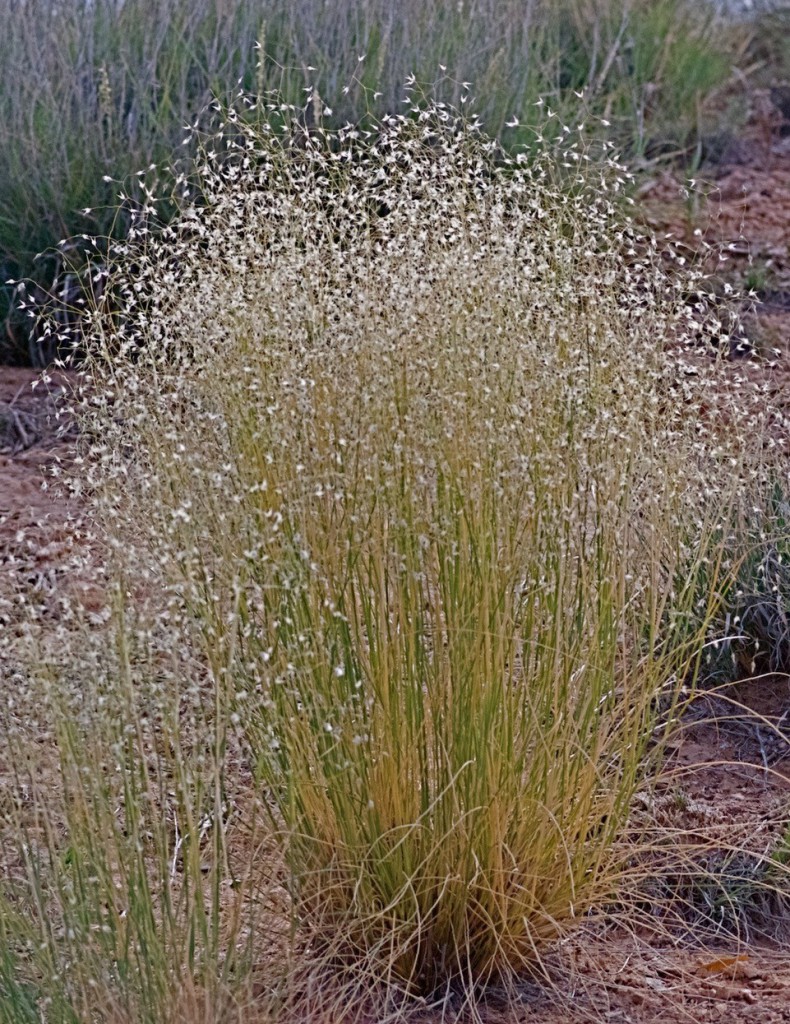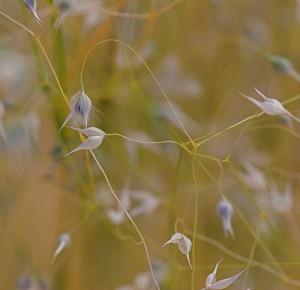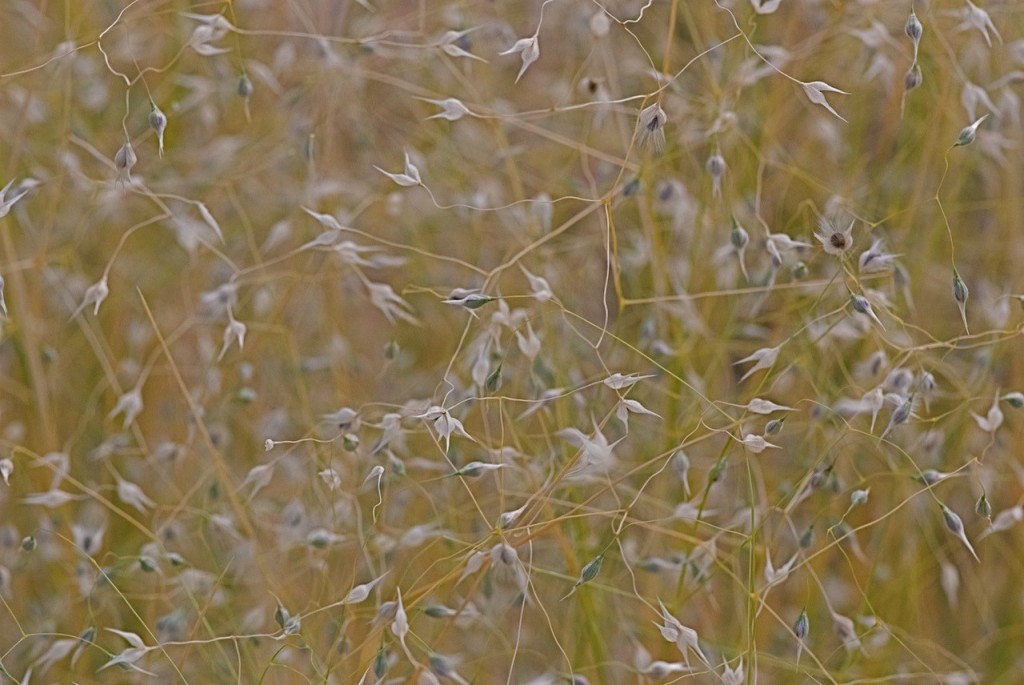Scientific name: Oryzopsis hymenoides
Synonyms: Achnatherum hymenoides, Stipa hymenoides
Common names: Indian ricegrass, mountain ricegrass, arroz indio in Spanish, Indian millet
Family: Poaceae
*FYI: There is an ongoing debate among taxonomists as to which is the accepted scientific name. Time will tell.
by Jeanne Gozigian

Indian ricegrass (Photo: Janice Tucker)
The beautiful, graceful Indian ricegrass is a favorite of mine. When I first saw it in the wild, in our property’s arroyo, I thought, “Wow, this is a wild rice!” No, it has no botanical relation to rice. But it is a formidable, gluten-free grain with incredible nutritional properties that have nourished wildlife and indigenous peoples from time immemorial. It is thought that it might not have enough protein for some ungulates but it is protein rich for humans. And it is so beautiful that it can be used as a substitute for baby’s breath in a bridal bouquet!
Achnatherum refers to needlegrasses, Oryzopsis is from the Greek oruza for rice and opsis, meaning appearance, while hymenoides means, membranous. This grass is native to western North America east of the Cascades, extending all of the way to Texas. It is a cool season bunchgrass preferring dry loamy, sandy or gravelly soils and prefers full sun. It is drought tolerant; its fibrous root system absorbs nutrients from the soil, allowing for good seed production. Large numbers of vigorous seeds lend stabilization to sites subject to soil erosion. Planted in partnership with Stipa comata, (needle and thread grass), it makes possible early propagation of disturbed sites, providing excellent range for livestock and wildlife.
The brown or black seeds of Oryzopsis hymenoides are very nutritious for birds such as mourning doves, pheasants and other songbirds. Even more important, Indian ricegrass was a staple food for Native Americans for thousands of years. Until the introduction of corn, Indian ricegrass alone was harvested, dried, winnowed, roasted and ground into flour. Then it was cooked into porridges and flat breads. The Apaches added cornmeal and rolled it into dumplings. In addition, Havasupai, Hopi and Zuni tribes were dependent upon it for nutrition.

Indian ricegrass seed heads up close (Photo: Janice Tucker)
Other historic uses were:
– Raw seeds were chewed to relieve stomachache, colic and aching bones.
– Cooked seeds were combined with other ingredients and eaten as dumplings.
– Seeds were added to soups and stews to boost nutrition.
– Seeds ground into flour were combined with cornmeal to make jonnycakes.
Oryzopsis hymenoides grows in the intermountain basins of the western United States, along with big sagebrush, winter fat, wheat grasses, blue grama and junipers, between 2,000 and 10,000 feet in elevation. The 8-10 inch stems, with lightly rolled leaves, are topped by trailing, 6 -inch branches. The open branches lead to a panicle inflorescence, 2 ½ to 6 inches long, with one or more pairs of spikelets (flower clusters). Each seed produced is nestled between a (palea) and (lemma) which comprise the bract, covered with white silky hair. The seed coat has a terminal tip called an awn, which is as long, or longer, than the seed.
Indian ricegrass was harvested in July or August by beating with light paddles and collecting the seeds in baskets. It requires less tilling than conventional grains, which protects the soil from wind erosion.

Indian ricegrass seed heads (Photo: Janice Tucker)
The roots harbor nitrogen-fixing organisms, contributing to the success of the species. The gluten-free product is said to be delicious and nutty flavored. The Montana Agricultural Development Council held a baking contest with Indian ricegrass flour marketed as “Montina” by Amazing Grains, a Montana Cooperative. As a gluten-free practitioner, I tried mightily to find it online, but it appears that the cooperative has gone out of business. Amazon once had it but it is no longer available. I guess that it comes down to calling every health food store in the country to locate this flour. I found a recipe for Montina pizza dough that the author says is the best gluten-free pizza he has ever eaten. I have friends helping me with the search. I must have it!
Oryzopsis hymenoides is the state grass of both Nevada and Utah, but has been listed as endangered in Minnesota since 1984. In Santa Fe, New Mexico, it is being grown in the Ojo y Manos area of the Botanical Garden at Museum Hill. It also occurs at the Leonora Curtin Wetland Preserve, part of the Botanical Garden. Will the children’s program kids one day be harvesting, roasting and grinding Indian ricegrass to make flour?
Thanks to Helen Woody and Janice Tucker for proofreading this article.
Sources:
American Indian Health and Diet Project, www.aihd.ku.edu/foods/indian_ricegrass.html
US Forest Service, www.fs.fed.us/wildflowers/plant-of-the-week/achnatherum_hymenoides.shtml
GRIN Global plant list, https://npgsweb.ars-grin.gov/gringlobal/taxonomydetail.aspx?402285
GoodFood World, www.goodfoodworld.com/2011/09/on-the-road-montina
Helena Independent Record, http://helenair.com/lifestyles/recreation/indian-ricegrass-looks-delicate-bakes-well/article_14f3ebbb-49f6-56e8-9668-ec0bfbd7cc2d.html
Lady Bird Johnson Wildflower center, https://www.wildflower.org/plants/result.php?id_plant=achy
The Nature Niche, https://thenatureniche.com/2013/09/13/indian-ricegrass/
The Plant List, http://www.theplantlist.org/tpl1.1/record/kew-426790
Northern Arizona University, http://jan.ucc.nau.edu/plants-c/bio414/species%20pages/Achnatherum%20hymenoides.htm
SEINet, Arizona-New Mexico chapter, http://swbiodiversity.org/seinet/taxa/index.php?taxon=2131
USDA Plants Database, https://plants.usda.gov/core/profile?symbol=achy
USDA Forest Service, https://www.fs.fed.us/wildflowers/plant-of-the-week/achnatherum_hymenoides.shtml


